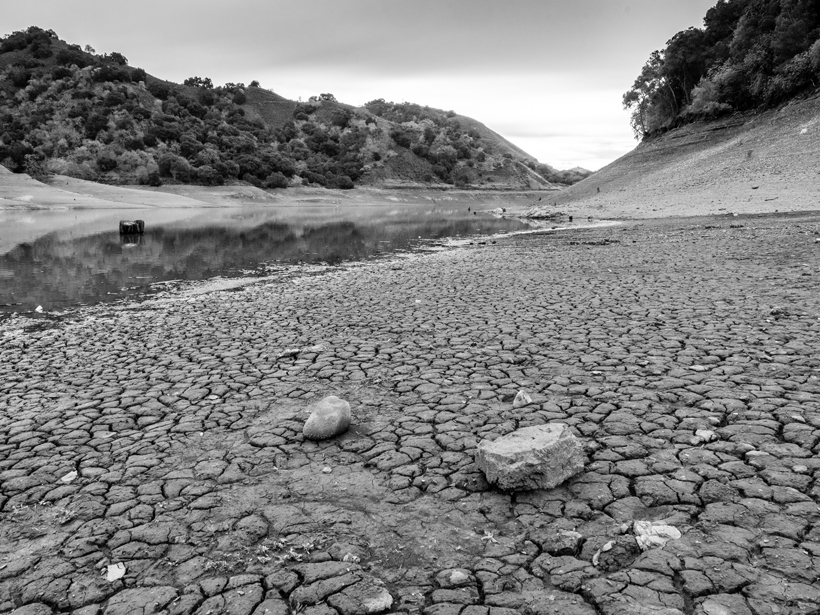With much of the drought-stricken western United States facing a potentially harsh fire season, the White House has allocated more than $110 million to deal with these hazards and their economic impacts.
“We are focused on and concerned about the impact of drought on economic and social conditions across the western United States.”
The White House also has called for improving the way that the U.S. Forest Service (USFS) funds forest fire–fighting efforts so that the money is not diverted from other agency priorities.
“We are focused on and concerned about the impact of drought on economic and social conditions across the western United States,” said White House Senior Advisor Brian Deese at a 12 June briefing. The very dry conditions, which federal forecasts indicate will likely intensify, also mean that the wildfire season is expected to be “acute” in large parts of the West, he noted. The briefing took place following a meeting between President Barack Obama and governors of western states earlier in the day.
Funding Details
Funding announced 12 June includes $6.5 million for the Bureau of Reclamation to support water management improvement programs, $10 million for the Department of the Interior (DOI) to fund 10 Wildland Fire Resilient Landscapes projects, and $30 million for the Department of Agriculture (USDA) to expand crop insurance relief.
The money also will provide up to $18 million for the Department of Labor to award to California, allowing the state to provide jobs for people who have been dislocated by the drought. Californians will lose about 18,000 jobs due to the 2015 drought, according to a June 2015 study by the University of California, Davis, Center for Watershed Sciences, cited by the White House.
Thirty-five percent of the landscape in the West is in severe or exceptional drought, Deese said. The newly announced funding adds to $190 million the federal government already has invested this year to address the water crisis.
The White House also anticipates that USDA could spend at least $1.2 billion to compensate farmers and ranchers for grazing losses in 2015 through its Livestock Forage Disaster Program. That program paid out more than $4 billion over the last 3 years.
Deese characterized the new funding as “just a next step in an ongoing, very aggressive, all-of-government effort” to respond to drought and related wildfire risk.
Reforms Proposed for Wildfire Management Funding
“We have a budgeting system that is self-defeating and is undermining our federal government’s ability not just to fight fires but reduce the likelihood of fires in the future.”
Currently, USFS makes intra-agency transfers of funds to cover expenses for wildfire management. Although Congress usually repays these funds within several months, the transfer hinders other USFS efforts to manage forests.
“We have a budgeting system that is self-defeating and is undermining our federal government’s ability not just to fight fires but reduce the likelihood of fires in the future,” Deese said.
Robert Bonnie, under secretary for Natural Resources and the Environment at USDA, said that legislation introduced in both houses of Congress—the Wildfire Disaster Funding Act (House Resolution 167 and Senate Bill 235)—would create a fund that USFS and DOI can draw on during particularly bad years. The White House’s proposed fiscal year 2016 budget also includes a funding fix modeled after the congressional proposals.
The legislation would ensure “that we don’t take resource[s] from the nonfire portion of the budget, the very portion of the budget that allows us to do the work to reduce fire hazard in the first place,” Bonnie said. The new funding approach would enable “investments in forest restoration in order to reduce the threat of catastrophic fire over the long term,” he added, noting that the legislation has broad bipartisan support in Congress. It also has received support from the timber industry, the environmental and outdoor recreation communities, and others, he said.
USDA anticipates an above-average fire season, particularly in California and the Pacific Northwest in August and September. Bonnie said that the fire season today is about 60–80 days longer than it was a few decades ago, the number of acres that burn has doubled over the same time frame, and there are now bigger and more catastrophic fires.
—Randy Showstack, Staff Writer
Citation: Showstack, R. (2015), White House focuses on drought and wildfire threats, Eos, 96, doi:10.1029/2015EO031727. Published on 18 June 2015.
Text © 2015. The authors. CC BY-NC 3.0
Except where otherwise noted, images are subject to copyright. Any reuse without express permission from the copyright owner is prohibited.

